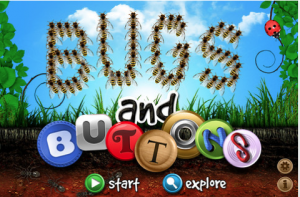“At their best, these applications that live in the spaces where education and entertainment overlap can capture the imagination, enticing students to learn on their own.”
(Educause, 2011 7 Things You Should Know About iPad Apps for Learning)
Overview
With the recent explosion of mobile devices (smart phones and tablets), and a new shift in thinking towards acceptance of how these devices can be used in an educational setting, it is only a matter of time before educational institutions will embrace the potential for mobile educational gaming.
As cited by TechCrunch in Cisco’s “Visual Networking Index (VNI) Global Mobile Data Traffic Forecast Update”; the number of mobile devices will exceed the world’s population by the end of 2012, and it is expected that by 2016 their will be 1.4 mobile devices per person on the planet. These devices are highly networked, and have surprising sufficient processing power.
Ingerman & Yang (Educause, 2011) list mobile technologies as the number one issue that IT leaders felt would become increasingly important, as educational institutions that traditionally have relied on wired, institutionally-owned hardware have had their wireless networks stretched to capacity by user-owned mobile devices. This shift in thinking has caused IT departments of school boards to alter their thinking from the “walled garden” mentality where all the hardware is owned, updated and maintained by the institution and personal devices have been denied access to the networks, to an approach where open (or filtered) networks are open and ubiquitously provided on the campus to meet a wide range of mobile devices.
School boards and post-secondary institutions, which in the past have been reticent about allowing students to bring their own mobile devices into the classroom, are starting to see the benefits of being more open and accepting to the idea of students bringing their devices to school to support their learning. With the increasing use of tablets as e-readers and a further push to e-textbooks, the prevalence of iPads and other tablets in the classroom is likely to increase.
Advantages
Some of the financial benefits include:
- Saving capital costs by not having to provide mobile devices, or hard-wired computers, to each student
- Decreasing costs to remain current with software installed on computer stations throughout the campus, as mobile applications are relatively inexpensive in comparison
Some of the educational benefits include:
- Since tablets blur the line between entertainment and education they are creating a more enticing tool for certain learning styles.
- “At their best, these applications that live in the spaces where education and entertainment overlap can capture the imagination, enticing students to learn on their own.” (Educause, 2011)
- Mobile devices appeal to multiple learning-styles including visual, audio and kinesthetic. (Educause, 2011)
Unique Considerations for Mobile Gaming
In 2007, Purdue University did a study on mobile educational games and came up with the following list of considerations:
- Limited screen resolution- screen resolution is improving dramatically
- Variable input controllers- touch screen or small keys
- Variable processing power- processing power is now rivalling many computers
- The player’s surroundings- players may be in transit, bored and waiting for something
- Phones are networked (potential to overwhelm existing wireless networks)
- Competing OS (operating systems- Android vs. iOS for example)
Most of these factors are still very real considerations with the addition of the last two.
Examples of Mobile Educational Games
The prevalence of “mobile-centric” applications means that far more developers are putting their energies towards mobile devices (Gartner, 2012) and seeing the potential for gaming that is reaching a broader audience than just traditional gamers. For example, in 2011 TechCrunch reported that Mind Snacks raised $1.2 million in capital to develop mobile learning games for foreign languages and test preparation. Mind Snacks uses a tight connection with social media, like Facebook, to encourage users to upload their scores etc. to engage, maintain and encourage its users.
Develops mobile educational games for learners of all ages, primarily in foreign language learning.
Brain Trainer by Luminosity
 Luminosity claims to partner with researchers from Stanford, Columbia and Harvard to create cognitive exercises (or brain games) for your brain to help: sharpen memory, focus attention, enhance creativity & reach peak performance. When you sign up for an account, Luminosity asks you a series of questions and creates a personalized training program for you.
Luminosity claims to partner with researchers from Stanford, Columbia and Harvard to create cognitive exercises (or brain games) for your brain to help: sharpen memory, focus attention, enhance creativity & reach peak performance. When you sign up for an account, Luminosity asks you a series of questions and creates a personalized training program for you.
Another developer of educational mobile games for youngsters. Click here to learn about one of their most popular games ‘Bugs and Buttons’.
USAid & Health-Based e-Gaming
USAid partnered with ZMQ India (a social business engaged in creating awareness on critical health challenges such as HIV/Aids, tuberculosis & malaria) to develop a mobile educational game to educate the population about HIV/AIDS. The partnership recognized the ability to penetrate the population through mobile phone applications, especially in developing countries where mobile phones are so prevalent. This is a low-cost high penetration (50 million downloads) approach to get the message out to a broad spectrum of the population for less than .02$/person. Try the game.
 AppAnnie provides analytics on the burgeoning app marketplace. The web site provides charts and links of the top (paid and free) Educational Games for iPad, iPhone and Android. Check out the charts here for many more examples of educational mobile games.
AppAnnie provides analytics on the burgeoning app marketplace. The web site provides charts and links of the top (paid and free) Educational Games for iPad, iPhone and Android. Check out the charts here for many more examples of educational mobile games.
References
Educause (2011). 7 Things You Should Know About iPad Apps for Learning. Retrieved May 27, 2012 from Educause web site: http://net.educause.edu/ir/library/pdf/ELI7069.pdf
E-Games- Educational Games at Purdue (2007). Retrieved May 25, 2012 from http://www.e-games.tech.purdue.edu/mobileGames.asp
Ingerman, B. L. & Yang, C. (2011). Top-Ten IT Issues, 2011, EDUCAUSE Review, vol. 46, no. 3 (May/June 2011). Retrieved May 27, 2012 from http://www.educause.edu/ero/article/top-ten-it-issues-2011
Mobile Educational Games. US AID (video file). Retrieved from http://youtu.be/DTPqgdd6_CA
Perez, S. (2012). The Number of Mobile Devices Will Exceed World’s Population By 2012 (& Other Shocking Figures). Retrieved May 29, 2012 from http://techcrunch.com/2012/02/14/the-number-of-mobile-devices-will-exceed-worlds-population-by-2012-other-shocking-figures/
Authored by David McInnes

